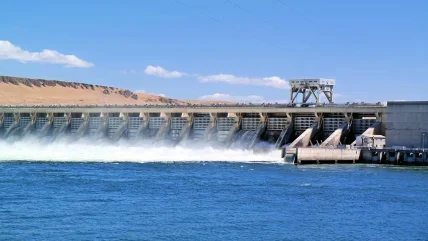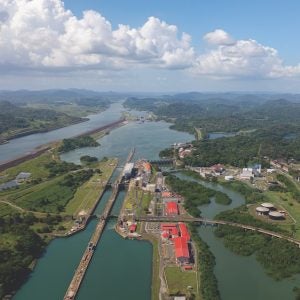
Thousands have registered for the 2021 World Hydropower Congress, which has now gone fully virtual. What was previously a three-day event hosted in cities such as Paris, Addis Ababa and Beijing, is now online, three weeks-long, free and available to all.
Taking place from 7-24 September, the event organised by the International Hydropower Association (IHA) will showcase how sustainable hydropower is part of the solution to climate change. Across more than 30 events, decision-makers, innovators and experts will set out how investment is urgently needed to build the smart, resilient, clean energy infrastructure of the future.
“With the World Hydropower Congress, we are sending a clear message that sustainable hydropower will play a pivotal role in decarbonising the economy, providing jobs and long-lasting infrastructure,” says Eddie Rich, CEO of IHA.
International Water Power and Dam Construction is once again proud to be an official media partner. As a virtual event, the 2021 Congress is expected to bring a larger, more diverse audience than ever before. The Congress is hosted by the President of Costa Rica and supported by Instituto Costarricense de Electricidad (ICE), the winner of the 2019 IHA Blue Planet Prize.
A wide range of virtual sessions geared towards industry professionals will help organisations learn how to combine the latest industry approaches, trends and technologies. Session themes cover advancing energy and smarter tech, incentivising investments, tackling climate change, managing freshwater and achieving sustainability.
Industry leaders, financiers, policy experts, representatives from governments, international institutions and civil society from multiple countries will join the World Hydropower Congress. To encourage interactions between delegates, a Virtual Attendee Hub will ensure participants from multiple time zones can connect with each other and participate in the discussions online.
San José Declaration on Sustainable Hydropower
In the build-up, IHA has in recent months been seeking public feedback on a new manifesto for hydropower development, to be announced at this year’s World Hydropower Congress. Named in honour of the host’s capital city, the San José Declaration on Sustainable Hydropower will identify principles and recommendations to guide new hydropower developments and enhance the sector’s contribution to the energy transition.
The declaration has already gained the strong support of leading political figures, including former Australian Prime Minister Malcolm Turnbull. “The San José Declaration on Sustainable Hydropower is going to provide the blueprint for the new generation of hydropower, the construction and delivery of which is so critical if we are going to achieve the cut in emissions that we need, and keep global warming within tolerable constraints,” Mr Turnbull said in a recent interview.
New sustainability certification system for hydropower
The World Hydropower Congress will also see the launch of a new sustainability certification scheme for hydropower projects. The Hydropower Sustainability Standard will apply a rating to projects of any size or stage of development. This will incentivise and recognise responsible project developers, and help investors, governments and communities understand which schemes meet international environmental, social and governance (ESG) performance requirements.
The certification system builds on the Hydropower Sustainability Tools, a set of guidelines and assessment tools used by developers, operators and financiers. “The Hydropower Sustainability Standard will incentivise high-performing hydropower projects while helping to set minimum expectations for the whole sector,” says Mr Rich.
New recommendations to promote pumped storage
The International Forum on Pumped Storage Hydropower, a government-led multi-stakeholder initiative led by IHA and chaired by the U.S. Department of Energy, will issue a range of reports and recommendations during the World Hydropower Congress on the future of pumped storage hydropower.
The Forum has brought together 13 governments, 70 organisations, several multilateral development banks and research, development and financial organisations. The reports issued by the Forum cover recommendations for policy and markets which hold out the promise of finally unleashing the potential of this much under-valued clean energy storage technology.
New innovations hub for renewable energy
As part of the World Hydropower Congress, IHA has also launched a new platform for companies to help share knowledge and showcase their latest innovations. The Renewable Energy Innovations Hub features innovations falling under three broad themes: technology; research; and environmental, social and governance.
Some of the remarkable innovations include robots using artificial intelligence to monitor hydropower plant efficiency and decrease maintenance costs, hydropower battery hybrids that are being developed to improve grid services, as well as a ‘hyperloop for fish’ which has been designed to safely transport fish past dams.
Five unmissable virtual sessions for hydropower professionals:
The Hydropower Sustainability Standard: how to gain certification – 9 September
With hundreds of gigawatts of untapped potential worldwide, new and existing hydropower projects will continue to play an important role in global renewable energy production, as the world’s energy grid decarbonises.
The Hydropower Sustainability Standard, launched at this year’s World Hydropower Congress, will help to ensure that projects across the world are recognised and certified for their environmental, social and governance (ESG) performance.
Solar-hydropower hybrids: renewables working together – 14 September
Hydropower coupled with floating solar power presents a significant opportunity to scale up solar energy deployment around the world. When treated as a single generation source, solar power fluctuations and variability can be compensated by hydropower, resulting in water conservation, reducing spinning reserve requirements and the efficient use of existing transmission and distribution infrastructure.
This session will bring first-hand experience from pioneers and discuss what must to be done to unlock this vast potential on hydropower reservoirs. The session will explore the market and regulatory barriers to increasing the uptake of this technology worldwide.
Modernising hydropower: getting more from existing assets – 15 September
Investing in existing assets can offer a range of low-impact benefits – from upgrading ageing equipment, to improving energy performance, advancing digitalisation, reducing environmental impacts and complementing variable renewables coming onto the grid.
Drawing from projects across the sector, this session will discuss the opportunities and challenges for hydropower modernisation with a focus on attracting more investment to the modernisation of the existing hydropower fleet.
Smart hydropower: extending power system flexibility – 17 September
Smarter technologies are now available to equip hydropower plants for the challenges ahead – improving fast-response power, efficiency, availability, and digitalising systems. Innovative approaches can optimise performance of hydro assets, while also ensuring they can compete in new and evolving electricity markets. Building a wider understanding of the types of technology options and benefits achievable will help inform future investments in both new and existing hydro projects.
This session will give an overview of innovative technologies and approaches from the XFLEX HYDRO initiative, an EU-funded consortium of industry and research partners piloting new technologies and methods to enhance hydropower’s operational flexibility. Drawing on the European demonstration sites, organisations involved in XFLEX HYDRO will present the progress achieved through the project.
Retrofit, refurbish or remove: how to make the right choice? – 20 September
According to ICOLD less than 20 per cent of the world’s large dams are used for hydropower generation. Compared to the construction of a new dam, retrofitting could offer a cost-effective way to increase electricity production. With an ageing hydropower fleet in Europe and North America, the International Energy Agency reports that hydropower projects will require significant investments in refurbishment.
This session will explore the different life cycle options for existing dams and discuss when it might be the best decision to retrofit, refurbish or remove. Regardless of any decision to retrofit, refurbish or remove, hydropower developers and operators must ensure that environmental and social considerations are taken into account to protect the health of rivers.






